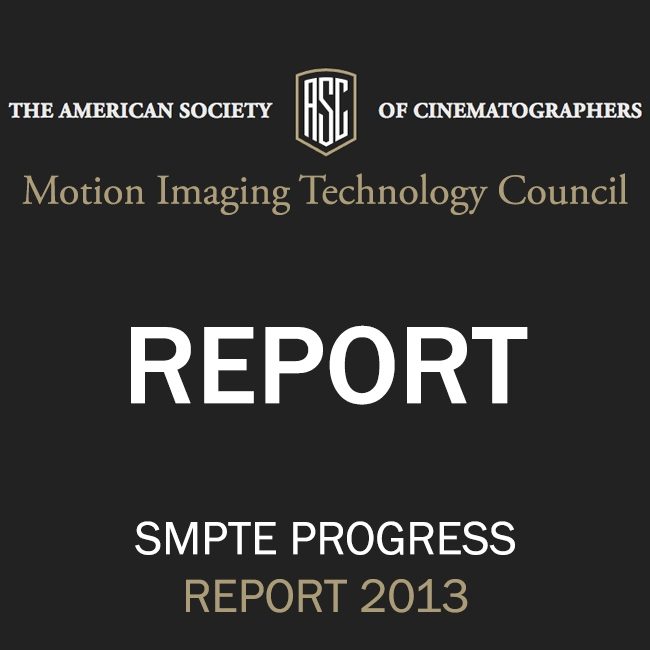Report Authors
Curtis Clark, ASC; David Reisner; David
Stump, ASC; Ron Garcia, ASC; Lou Levinson;
Al Barton; Ron Burdett; Bill Feightner; Gary
Demos; Don Eklund; Eric Rodli; Steve Schklair;
Garrett Smith; John Scheele; David Morin
ASC Technology Committee
Officers
Chair: Curtis Clark, ASC
Vice-Chair: Richard Edlund, ASC
Vice-Chair: Steven Poster, ASC
Secretary: David Reisner, D-Cinema Consulting
From its inception in 2003, the ASC Technology Committee has been
guided by its primary mission to engage and influence motion imaging technology developments in ways that better serve and protect the
filmmaker’s creative intent and the role of the cinematographer in realizing a creative vision.
Since our last report in September 2012, very constructive ongoing
work has been done by our ASC Technology Committee and subcommittees that follow through with the excellent work that was accomplished between September 2011 and September 2012. Significant advances that were being made regarding on-set/near-set workflow for
look and data management of digital camera images dominated the
content of our 2012 report. 4K spatial resolution derived from camera
RAW was beginning to make its mark, but the broader implication of
its creative significance was only just starting to be understood. With
greater practical experience gained from using 4K cameras (especially
the Sony F65 and Sony F55) for both theatrical motion picture and TV
scripted drama production, the superior imaging attributes of greater
bit depth, wide color gamut and 4K using ACES (the Academy of Motion Picture Arts and Sciences (AMPAS) Academy Color Encoding
System) color management, have become increasingly clear.
Creative Importance of 4K Spatial Resolution
From a creative perspective, greater spatial resolution (e.g., 4K) is a vital component of a creatively enhanced digital motion imaging canvas
that also needs to include wide-gamut color with increased color bit-depth, e.g., 16-bit, along with the ability to reproduce a high dynamic range of scene tones consisting of at least 14 stops. The fusion of
4K spatial resolution with 16-bit wide-gamut color and high dynamic
range produces a superadditive synergy where the resulting effect is
greater than the simple sum of each component’s effect on its own.
The ability to reproduce more finely resolved (4K) image detail can
now take full creative advantage of increased color bit-depth code
values (e.g., 65,000+ CVs for 16-bit) to reproduce more nuanced
color and tonal contrast. Working in ACES both preserves 16-bit
wide-gamut color from camera RAW and facilitates greater precision in the color grading. Even though many current projectors
and monitors display only 10 bits, preserving 16-bit wide-gamut
color in the ACES master effectively preserves the creative content for future display devices that will be able to display greater bit-depth images containing significantly improved contrast,
along with higher resolution and increased image brightness.
Another crucial advance regarding the importance of 4K is the ability (and need) to differentiate the effect of grater spatial resolution
from image sharpness. Unfortunately, resolution and sharpness are
frequently and mistakenly conflated. As the latest generation of 4K
digital motion picture cameras move beyond the constraints of HD
(1920 x 1080) spatial resolution, we can leave behind the HD video camera imaging parameters, which invariably incorporate degrees of electronic image sharpening that are intimately associated
with a video look. The latest digital motion picture cameras, for example the F65 and F55, rely primarily on greater spatial resolution
and tonal contrast as does lm. This can facilitate a more filmic
look for the digital camera image. Of course, camera lens selection
is equally vital regarding resolution and contrast, as the apparent
photographic sharpness of the image is ultimately dependent on
lens performance and accurate lens focus at the camera focal plane.
In summary, 4K spatial resolution (without artificially enhanced electronic image sharpening), along with wide-gamut color with great-
er bit-depth, enables the digital motion picture camera to obtain a
more lmic look, especially using ACES color encoding. This perspective is vital for motion pictures made for theatrical release, but
also very relevant for scripted TV dramas. It is also important for the
future UHDTV and the upcoming new 4K Blu-ray standards.
Our new UHDTV subcommittee chaired by Don Eklund is proactively addressing the consequences of 4K UHDTV (quad HD) and
the next generation Blu-ray standard, as well as the next generation
4K display devices.
Our Motion Imaging Worklow subcommittee, co-chaired by Al
Barton, Ron Burdett, and Bill Feightner, is applying the lessons being learned from our on-set/near-set testing with ACES color encoding to create a set of best practice worklow recommendations.
Our new Laser Projection subcommittee, co-chaired by Eric Rodli and
Steve Schklair, is addressing the next-generation laser projection.
We also have important reports from our Advanced Imaging sub-committee, chaired by Gary Demos, vice-chaired by Jim Fancher and
Phil Feiner; our Virtual Production Committee, chaired by David
Morin and co-chaired by John Scheele; reports from our Camera and
Metadata subcommittees, chaired by David Stump, ASC; and our
Enlightenment subcommittee, chaired by Ron Garcia, ASC.
Special mention should be given to the work of our Digital Finishing (formerly Digital Intermediate) subcommittee, chaired by Lou
Levinson and vice-chaired by Josh Pines with David Reisner serving
as secretary. We are the proud recipients of a 2012 Primetime Emmy
Engineering Award for our ASC CDL. We are also proud to have been proactive contributors to the success of ACES, which was also given a
2012 Primetime Emmy Engineering Award received by AMPAS.
Curtis Clark, ASC
ASC Technology Committee Chair
